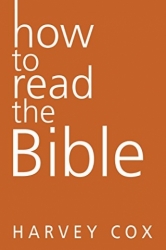A quick search online reveals dozens of books with some variation of the phrase “how to read the Bible” in the title. By writing a book with this title, Harvey Cox joins a crowded field, but his take on the subject is sufficiently unique to distinguish this book from the others. Cox served as the Hollis Professor of Divinity at Harvard Divinity School. He has contributed to the study of theology through a post-modern lens; much of his research focuses on liberation theology and the relationship between the sacred and the secular. This book stands out because it brings his experience to bear and represents the minority position as a non-conservative voice among popular level books about devotional reading of Scripture.
Overview
The book begins with an introduction that lays out Cox’s own faith journey and outlines the thee parts of Cox’s model for reading the Bible. He calls for readers to read Scripture as a story, to study its history, and for its spiritual benefit. These three stages of reading form the rubric for the remainder of the book.
After the introduction, Cox divides his volume into ten chapters, with a separate conclusion. Each chapter focuses on his proposed method of reading a book or a genre within Scripture. Chapter One deals with Genesis. Cox demonstrates his application of a historical reading by adopting the documentary hypothesis for reading Genesis. Since Genesis is a splicing of four or more sources that were written in the in the seventh century B.C.E., the book can be read as a sample of ancient literature and perhaps to consider the immorality of the characters. Most of this chapter is focused on demonstrating the unreliability of the text as history. In the second chapter, Cox celebrates reading Exodus for entertainment but rules out reading it for any historical value. The miracles in Exodus reflect the naiveté of the original audience instead of divine interventions in history. By introducing informed skepticism Cox hopes to present a “mature approach” to the biblical text (pg. 50).
This general approach to Scripture continues through Chapter Three where Cox presents events of the book of Joshua as examples of later political propaganda used to justify genocide. Mixed in with horrific accounts of slaughter are stories like the account of Rahab and the Spies, which is a “dinner-theater fluff piece” written as “comedy with a purpose.” (pg. 69) The fourth chapter promotes Job as a purely fictional account that justifies defying God, though if it offers little help for explaining theodicy according to Cox. In Chapter Five Cox explains that the value of the prophets is in giving a voice to the voiceless. In dealing with the genre of prophecy, Cox affirms his reader-centric hermeneutic, though he notes that context limits the ability to reinterpret the calls for justice. (pg. 105)
Chapters Six and Seven deal with the Gospels. In Chapter Six, Cox promotes a political understanding of canonization, recommending the study of extrabiblical gospels as equally valuable. The seventh chapter focuses on various redaction and source critical theories of the Synoptic Gospels, ending with an affirmation of the quest for the historical Jesus. In Chapter Eight, Cox takes on Paul, who was certainly redeemed, but often mistaken with regard to his ethics. In any case, many of the objectionable claims Paul makes were likely not actually written by him. The ninth chapter recommends reading the book of Revelation in light of how it has influenced believers in the past; it is a text about enduring during suffering but not at all predictive.
In Chapter Ten Cox circles around to summarize his hermeneutical methods, commending appreciation of both artistic and non-Christian interpretations of Scripture for the benefit of believers. Cox closes the book with a brief conclusion where he wrestles with the significant question that rises from his book: Why should one read the Bible? Though the Bible is “ridiculous and incredible” (pg. 227), “obsolete” (pg. 228), and “dangerous” (pg. 229), Cox recommends reading it to learn about God and self. The question remains whether, after gutting the text of supernatural content, there is anything left of God to be seen in the text.
Reflections
Because this book falls so far outside our theological bounds it is obviously not one that Books At a Glance can endorse. But it is a clear example of the application of the post-modern reader-response method of reading to the text along with modernistic so-called higher textual criticism. Cox is honest in his rejection of the content of Scripture. There is little reason to suspect that he is anything but sincere in his encouragement to read the Bible, despite its many flaws. For conservative Christian readers, this book helps to explain how some who self-identify as Christians can reject what seem to be clear ethical teaching within Scripture: they have first rejected the integrity, historicity, and veracity of Scripture. What is left is a collection of ancient artifacts that may have some Spiritual value for encouragement toward ethical action consistent with modern standards as long as the right skepticism is applied to the text. For the Evangelical reader, this is an artifact that clearly demonstrates a hermeneutic often hidden in public discourse. It is valuable because it is plain spoken.
Students should read How to Read the Bible for a clear understanding of the reader-response approach to the Bible. Pastors should be aware of this volume so they can provide discerning counsel to their congregants. The average layperson can benefit by reading this book with an awareness of its bias for the purpose of understanding the reason for radical shifts expressed in some versions of Christian ethics in contemporary debates.
